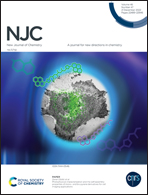Effect of P on hydrodeoxygenation performance of Ni–P/SiO2 catalysts for upgrading of m-cresol
Abstract
To deeply understand the role of P in hydrodeoxygenation (HDO), SiO2-supported Ni and Ni–P catalysts with different P/Ni ratios (x) were prepared. The as-prepared samples were characterized by various characterization methods. The HDO activity and product distribution over the Ni/SiO2 and N–P/SiO2-x were compared and the effects of x on the structure, acidity, formation mechanism of active phases and HDO performance were studied taking m-cresol HDO as a model reaction. The results showed that the introduction of P promotes the formation of smaller active sites and contributes to the creation of weak and medium strength acid sites through the formation of P–OH groups and Niδ+ in Ni2P. HDO over the Ni/SiO2 catalyst occurs mainly via the hydrogenation (HYD) route with 3-methyl-cyclohexanol (3-MCHnol) as the main product. However, for Ni–P/SiO2-x catalysts, methyl-cyclohexane (MCH) selectivity increases first and then decreases with the increase of x, reaching a maximum of 95% at x = 1. The acidity generated by the introduction of P contributes to increased MCH selectivity, while the dehydration of 3-MCHnol to MCH occurs mainly on acid sites. However, the excessively high P content (x ≥ 2.0) leads to a significant increase of MB (toluene) selectivity, which is associated with the increase in Ni(I) sites. About 100% m-cresol conversion was achieved with Ni–P/SiO2-1.0 when the m-cresol (g)/catalyst (g) ratio was 3, with MCH (99.4%) as the major product, showing great promise for deep HDO catalysis.



 Please wait while we load your content...
Please wait while we load your content...